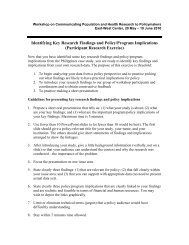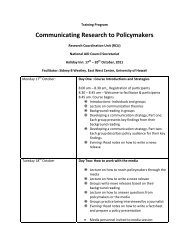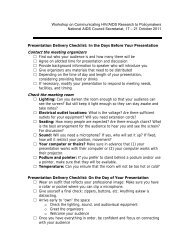How to conduct an information briefing - Communicating with ...
How to conduct an information briefing - Communicating with ...
How to conduct an information briefing - Communicating with ...
You also want an ePaper? Increase the reach of your titles
YUMPU automatically turns print PDFs into web optimized ePapers that Google loves.
Give <strong>an</strong> effective <strong>information</strong> <strong>briefing</strong><br />
• Prepare a <strong>briefing</strong><br />
• Deliver a <strong>briefing</strong><br />
• H<strong>an</strong>dle questions<br />
<strong>an</strong>d <strong>an</strong>swers<br />
<strong>Communicating</strong> HIV/AIDS Research<br />
<strong>to</strong> Policymakers<br />
Port Moresby, Papua New Guinea<br />
Oc<strong>to</strong>ber 2011
An effective <strong>briefing</strong> should…<br />
• Grab attention<br />
• Hold interest<br />
• Build underst<strong>an</strong>ding<br />
• Gain accept<strong>an</strong>ce<br />
• Ensure retention<br />
• Stimulate action<br />
2
Prepare a <strong>briefing</strong><br />
• Analyze your audience<br />
• Be clear about your objective<br />
• Know your material thoroughly<br />
• Define your main messages (1–3<br />
maximum) <strong>an</strong>d supporting points: Write<br />
out a short outline <strong>an</strong>d notes<br />
• Create <strong>an</strong> appropriate introduction <strong>an</strong>d<br />
conclusion<br />
3
Tips for org<strong>an</strong>izing your <strong>briefing</strong><br />
• State your main message early<br />
• Reinforce your message throughout<br />
• Include examples that give your findings<br />
a hum<strong>an</strong> face<br />
• Restate your message in your<br />
conclusion<br />
• Practice<br />
4
Deliver your <strong>briefing</strong><br />
• Aim for credibility <strong>an</strong>d persuasiveness<br />
• Speak naturally <strong>an</strong>d make eye contact<br />
• Do not read your notes<br />
• Avoid technical jargon<br />
• Be succinct: Know when <strong>to</strong> s<strong>to</strong>p talking<br />
5
If appropriate…<br />
• Give the policymaker a nice prin<strong>to</strong>ut of<br />
a simple, compelling graph<br />
– That illustrates your key point<br />
• Discuss the graph <strong>with</strong> the policymaker<br />
6
H<strong>an</strong>dle questions <strong>an</strong>d <strong>an</strong>swers<br />
• Anticipate likely questions<br />
• Ak Ask policymaker <strong>to</strong> clarify the question<br />
• Disarm loaded questions: Don’t be<br />
defensive<br />
• Align your <strong>an</strong>swer <strong>with</strong> your main<br />
message<br />
• Get back later if you c<strong>an</strong>’t <strong>an</strong>swer<br />
question on the spot<br />
7
Support your <strong>briefing</strong> <strong>with</strong> a fact<br />
sheet<br />
• Give <strong>to</strong> policymaker at the end of your<br />
<strong>briefing</strong><br />
• Restates your main message <strong>with</strong><br />
supporting data<br />
• Includes full <strong>information</strong> on how <strong>to</strong> get<br />
back in <strong>to</strong>uch <strong>with</strong> you <strong>an</strong>d your<br />
org<strong>an</strong>ization<br />
8
The essence of <strong>an</strong> oral <strong>briefing</strong> is<br />
• NOT simply the <strong>information</strong> you give<br />
but rather<br />
• The CONNECTION you make between<br />
your <strong>information</strong> <strong>an</strong>d the policymaker’s<br />
concerns<br />
9













